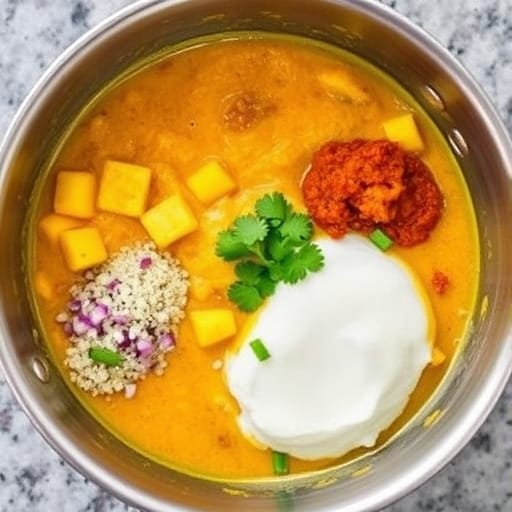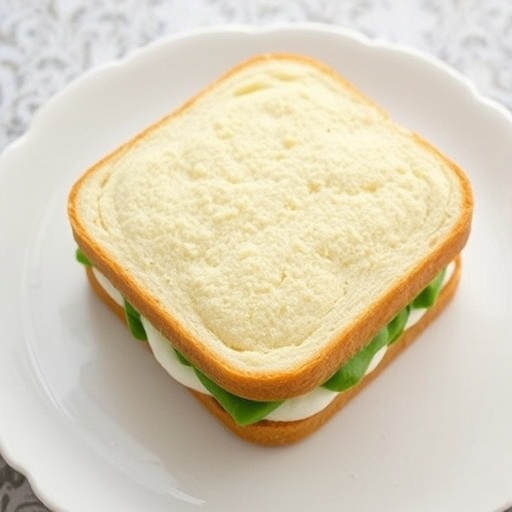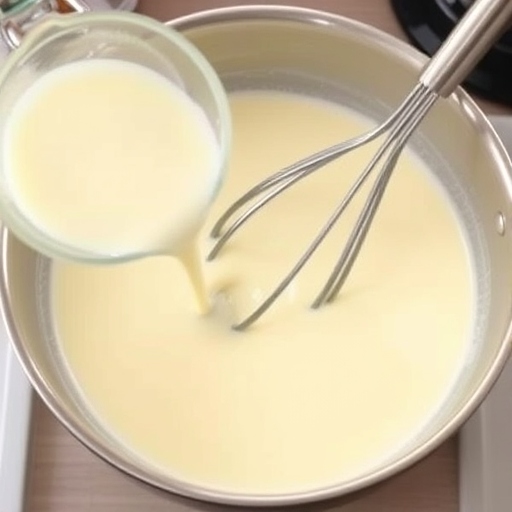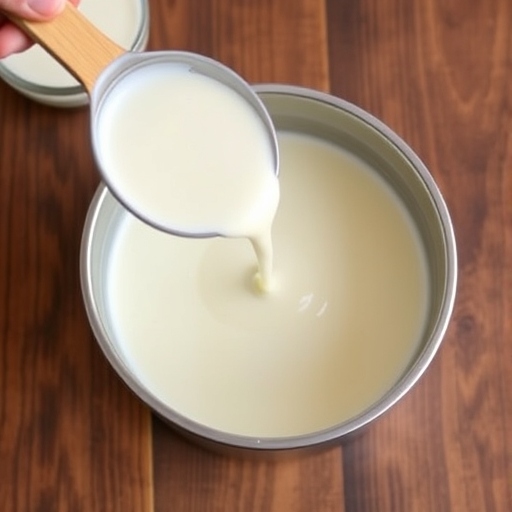Introduction
When it comes to starting your day with a burst of energy and flavor, a breakfast curry is an unconventional yet delightful way to fuel your morning. Packed with protein, vegetables, and aromatic spices, this breakfast curry is a savory alternative to the usual cereal or pancakes. It’s the perfect balance of comfort and spice, designed to give you a wholesome and satisfying breakfast to power through your day.
Table of Contents
1. The Story Behind Breakfast Curry
Curry is a cornerstone of many cultures around the world, particularly in South Asia, where its bold spices and diverse ingredients make it a beloved dish at all times of day. While curries are often associated with lunch or dinner, this breakfast curry is a modern twist that brings the robust flavors of a traditional curry into the morning routine. By adding elements typically found in breakfast dishes—like eggs, potatoes, and vegetables—this recipe combines the warmth of curry with the familiar comfort of breakfast foods, offering a new, exciting way to start your day.
2. The Benefits of Making Your Own Breakfast Curry
- Nutrient-Rich: Packed with vegetables, protein (like eggs or tofu), and healthy fats, this curry provides a balanced and nourishing meal to start your day.
- Customizable: You can easily modify the recipe to suit your dietary preferences, swapping out vegetables or proteins for what you have on hand.
- Flavorful Start: The combination of spices in this curry not only gives you a burst of flavor but also promotes good digestion and provides a comforting warmth.
- Quick and Easy: Despite the complex flavor profile, this breakfast curry can be prepared in under 30 minutes, making it a convenient option for busy mornings.
3. Essential Ingredients for the Perfect Breakfast Curry
To create a well-rounded breakfast curry, here’s what you’ll need:
For the Curry Base
- Olive oil or Ghee: 2 tablespoons for sautéing.
- Onion: 1 medium, chopped, for a flavorful base.
- Garlic: 3 cloves, minced, to add aromatic richness.
- Ginger: 1-inch piece, grated, for warmth.
- Tomatoes: 2 medium, chopped, or 1 cup of canned crushed tomatoes.
- Potatoes: 2 medium, peeled and diced, to add texture.
- Spinach: 2 cups, fresh or frozen, for a nutritious boost.
- Bell pepper: 1, chopped, to add sweetness and crunch.
- Eggs: 2–4, depending on preference, for protein.
For the Spice Mix
- Ground turmeric: 1 teaspoon for color and health benefits.
- Ground cumin: 1 teaspoon for a savory, earthy flavor.
- Ground coriander: 1 teaspoon for citrusy undertones.
- Ground garam masala: 1 teaspoon for the warm, aromatic finish.
- Chili powder or cayenne pepper: ½ teaspoon for a bit of heat.
- Salt: To taste.
For Garnish and Serving
- Fresh cilantro: Chopped, for a fresh, herby flavor.
- Greek yogurt or coconut yogurt: Optional, for creaminess and tang.
- Lemon wedges: For a zesty finish.
4. Cultural History of Ingredients
- Ginger, Garlic, and Turmeric: These spices are staples in many Indian and Southeast Asian cuisines, revered not only for their robust flavors but also for their medicinal properties, such as aiding digestion and reducing inflammation.
- Cumin and Coriander: These two spices are often paired together in curries and other savory dishes, offering earthy, nutty, and citrusy notes that balance the heat of chili.
- Spinach: A versatile leafy green that’s widely used in curries for its mild flavor and high nutrient content, particularly in Indian cooking.
- Eggs: Commonly included in savory curries in several cultures, eggs add protein and richness, making them a perfect breakfast ingredient.
5. Equipment You’ll Need
- Large skillet or frying pan: For sautéing the vegetables and cooking the curry.
- Lid: To cover the skillet when poaching the eggs.
- Knife and chopping board: For prepping vegetables.
- Spatula: For stirring and flipping the eggs.
- Measuring spoons: For accurate spice measurements.
6. Step-by-Step Instructions for Breakfast Curry
Step 1: Prepare the Vegetables
- Begin by heating olive oil or ghee in a large skillet over medium heat.
- Add the chopped onion and cook until it becomes soft and translucent, about 3–4 minutes.
- Stir in the minced garlic and grated ginger, cooking for an additional 1–2 minutes until fragrant.
- Add the diced potatoes and bell pepper. Cook, stirring occasionally, for about 5 minutes until the potatoes start to soften.
Step 2: Build the Curry Base
- Add the chopped tomatoes to the skillet and cook for another 3–5 minutes, allowing the tomatoes to break down and meld into the mixture.
- Stir in the spices—turmeric, cumin, coriander, garam masala, and chili powder. Mix well to coat the vegetables in the spices.
- Pour in a splash of water or broth to help create a sauce. Let the mixture simmer for 5 minutes, stirring occasionally.
- Add the spinach, cooking until it wilts down and integrates into the curry, about 2–3 minutes.
Step 3: Add the Eggs
- Make small wells in the curry mixture for the eggs. Crack an egg into each well, then cover the skillet with a lid.
- Let the eggs poach in the curry for about 5–7 minutes, or until the whites are set but the yolks are still runny. For fully cooked eggs, let them cook longer.
Step 4: Garnish and Serve
- Remove the skillet from the heat and sprinkle fresh cilantro over the curry.
- Serve the breakfast curry with a dollop of yogurt, a squeeze of lemon juice, and lemon wedges on the side.


7. Suggestions for Serving and Storing
- Serving: Serve with toasted naan or warm pita bread for a satisfying breakfast. You could also pair it with brown rice for a more filling meal.
- Storing: Leftovers can be stored in an airtight container in the refrigerator for up to 3 days. Reheat gently on the stovetop, adding a splash of water to revive the curry sauce.
8. Chef Simon’s Tips for Breakfast Curry
- Spice Level: Adjust the amount of chili powder and cayenne pepper to suit your heat preference.
- Vegetable Variations: Feel free to swap out the bell pepper and potatoes for other veggies like zucchini or cauliflower, depending on what you have on hand.
- Eggs: For a creamy touch, stir the eggs gently into the curry once they’ve poached to create a scrambled-egg texture.
9. Emotional and Psychological Impact of Food
Breakfast curry brings an emotional sense of warmth and satisfaction. The combination of spices can evoke memories of comforting meals with family or create a sense of adventure if it’s your first time trying a savory breakfast curry. The richness of the flavors, combined with the healthful ingredients, can make you feel nourished and energized.
10. Mindful Cooking Techniques
- Savor the Spices: Take a moment to enjoy the aroma of the spices as they bloom in the oil, releasing their natural oils and fragrances.
- Patience with the Potatoes: Allow the potatoes to cook until they’re golden and tender, creating a wonderful texture in the curry.
11. Tips for Keeping the Recipe Fresh Longer
- To keep the curry fresh, store it without the eggs and add the eggs when you reheat it. This ensures that the eggs maintain their perfect texture.
- For longer shelf life, avoid adding yogurt directly to the curry when storing. Keep it in a separate container and add it when serving.
12. Advanced Culinary Terms and Techniques
- Poaching Eggs: Poaching eggs in a curry allows the whites to set while the yolks remain soft and runny, contributing to a rich, creamy texture.
- Blooming Spices: Heating the spices in oil releases their essential oils, enhancing their flavor and aroma.
13. Healthy Ingredient Alternatives
- Low-fat Yogurt: If you’re looking for a lighter topping, substitute Greek yogurt with a low-fat version.
- Sweet Potatoes: Instead of regular potatoes, try using sweet potatoes for added fiber and nutrients.
- Non-dairy Yogurt: For a vegan version, opt for coconut or almond milk yogurt.
14. More Serving Ideas
- Pair with a refreshing cucumber salad with yogurt dressing to balance out the richness of the curry.
- Serve alongside some fresh fruit like sliced mango or pineapple to add a touch of sweetness.
15. Common Issues and Solutions
- Curry Too Thick: If the curry becomes too thick, add a little extra water or broth to loosen it up.
- Eggs Overcooked: If your eggs cook too fast and get rubbery, lower the heat and let them cook slowly.
- Too Spicy: Balance the heat by adding more yogurt or a splash of coconut milk.
16. Variations to Try
- Vegan Version: Skip the eggs and use tofu or tempeh for a plant-based version. Add extra vegetables like peas, cauliflower, or mushrooms to maintain a hearty texture.
- Meat Lovers’ Option: Add cooked chicken, sausage, or even crispy bacon for a more indulgent breakfast curry.
- Breakfast Curry Bowl: For a more complete meal, serve the curry over a bed of quinoa or brown rice, and top with your favorite garnishes such as avocado or a fried egg.
17. Nutritional Information and Health Benefits
This breakfast curry is a powerhouse of nutrients, offering a balanced combination of protein, healthy fats, and fiber from vegetables and eggs.
Per Serving (Approximate, based on 2 servings):
- Calories: 350–400 kcal
- Protein: 20–25g (from eggs and vegetables)
- Carbohydrates: 30–35g (from potatoes and vegetables)
- Fat: 20g (from olive oil/ghee and eggs)
- Fiber: 5–7g (from potatoes, spinach, and bell peppers)
- Vitamins and Minerals: High in vitamin A (from spinach and bell pepper), vitamin C (from bell pepper and tomatoes), and iron (from spinach).
Health Benefits:
- High in Protein: Eggs and vegetables provide essential protein for muscle repair and growth.
- Packed with Antioxidants: Spices like turmeric, garlic, and ginger have anti-inflammatory and antioxidant properties, which help reduce oxidative stress.
- Rich in Fiber: The inclusion of vegetables like spinach and potatoes offers plenty of fiber, which is essential for digestive health.
- Boosts Digestion: The ginger and garlic in the recipe help promote digestive health, while the curcumin in turmeric has been shown to support gut health.
18. The Art of Pairing Breakfast Curry
Breakfast curry pairs beautifully with a variety of sides and accompaniments. Here are some suggestions:
- Bread: Serve with naan or warm pita bread for dipping, soaking up all that delicious curry sauce.
- Fruit: A side of fresh fruit, like citrus or berries, can add a refreshing contrast to the richness of the curry.
- Beverages: Pair with a refreshing herbal tea or a light coffee to complement the bold spices of the curry without overpowering them.
19. Weather and Recipe Outcome
While breakfast curry is great all year round, it can be particularly satisfying during colder months when you’re craving something warm and comforting. The spices in the curry provide a cozy, warming effect, perfect for chilly mornings. In warmer climates, you may want to go lighter on the spices and serve the curry with a refreshing side salad to balance the heat.
20. Other Breakfast Recipes to Explore
If you’re a fan of savory breakfasts, you might also enjoy these recipes:
- Shakshuka: Poached eggs in a spicy tomato and pepper sauce, similar to the flavors of breakfast curry.
- Savory Oatmeal: Oats cooked with vegetables, eggs, and savory spices for a warm, hearty meal.
- Avocado Toast with Eggs: A simple yet delicious breakfast option, topped with a poached or fried egg.
21. Focus on Tools and Equipment
The following tools will make preparing this breakfast curry much easier:
- Heavy-bottomed skillet: A non-stick or cast-iron skillet works best for evenly cooking the curry and preventing burning.
- Lid for the skillet: Essential for poaching eggs directly in the curry.
- Chopping board and knife: To quickly prep your vegetables.
- Measuring spoons and cups: Ensure you’re adding the right amount of spices and ingredients for the perfect flavor balance.
22. Frequently Asked Questions (with answers)
Q1: Can I make this breakfast curry in advance? A1: Yes, you can make the curry ahead of time and store it in the fridge for up to 3 days. However, it’s best to cook the eggs fresh when you’re ready to serve, as eggs can become rubbery when reheated.
Q2: Can I make this recipe without eggs? A2: Absolutely! You can substitute the eggs with scrambled tofu or skip them entirely for a vegetarian or vegan version. The dish will still be full of flavor and satisfying.
Q3: How can I make the curry spicier? A3: To increase the spice level, add more cayenne pepper or fresh chilies to the curry. You can also add a spoonful of chili paste or hot sauce for extra heat.
Q4: Can I use frozen vegetables in this recipe? A4: Yes, you can use frozen vegetables like spinach or peas. Just be sure to thaw them before adding them to the curry to avoid excess water.
Q5: What if I don’t have some of the spices? A5: If you don’t have all the spices, you can adjust by using a curry powder mix or garam masala alone. Feel free to experiment with what you have available.
Conclusion
This breakfast curry is a bold, flavorful, and satisfying way to begin your day. Whether you’re craving something new or you want to make your mornings a little more exciting, this recipe provides a perfect balance of warmth, spice, and nourishment. With its customizable ingredients, it’s a dish that can cater to a variety of dietary needs, and it’s versatile enough to suit your personal taste. The combination of spices, vegetables, and protein-rich eggs will leave you feeling energized and ready to take on the day.
Try this recipe today and indulge in a comforting, hearty breakfast that’s far from ordinary!
















